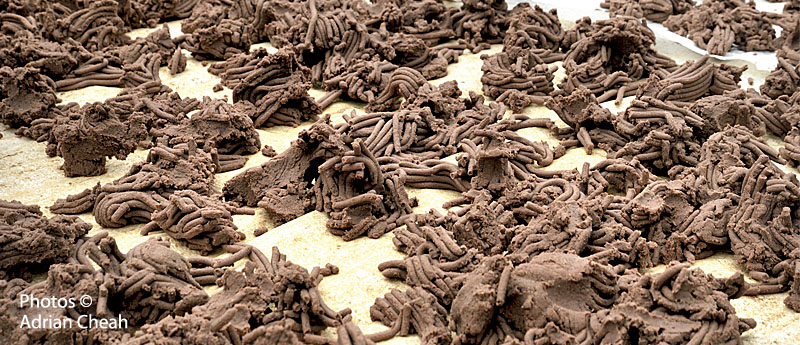Belacan, an integral ingredient in local cuisine

Anyone who has paid attention to local cuisine can safely hazard a guess that Penangites, and Malaysians for that matter, have a predilection for pungent foods! Call it full-flavoured, aromatic, spicy or downright nasty, Malaysian cuisine boasts more pungent varieties than arguably any other country in the world. This piquant character manifests itself in various forms, in fresh fruits (durian and jackfruit), in condiments (budu), preserves (cincaluk and tempoyak) and the innocuous-looking belacan or shrimp paste. The last item is as indispensable to Malaysian cooking as herbs are to Italian cuisine or soya sauce to Chinese. Why some purists go as far as to declare that your 'Malaysianess' hinges on whether or not you like belacan!
How did belacan come about? Necessity being the mother of invention, some conjecture that it was created out of a need by fishermen to preserve their catches for as long as possible. Also, certain sea creatures like minute shrimps are not very marketable and so new ways had to be invented to turn them into sellable commodities.


Fishermen catch the shrimps, drain them of water, salt them immediately, then dry them on huge metal beds placed on low stilts. The salt and decaying shrimps will eventually combine into a semi-solid tightly compacted pulp. The pulp is then pressed through a mill and passed out as a thread-like paste. The process is then reversed when the paste is repacked into sacks for the second round of fermentation. The fermentation process is repeated once more before full maturity occurs.


The final product is chopped into bricks, resembling blocks of butter. The mark of the producer is lightly etched on top of each block with a name press brushed with vegetable oil. Family members then wrap the blocks, first with greaseproof paper, followed by a plastic sheet then finally the outer wrap bearing the name of the product and manufacturer.

Belacan is used in countless local dishes: sambal belacan (de rigueur as a dip accompanying most Malaysian foods), laksa, belacan fried chicken, sambal tumis, fried cincaru, satay sauce and yummy rojak. Good quality belacan can be obtained from Gertak Sanggul and Batu Feringgi. However, it is Pulau Betong (a village located at the south-western tip of Penang island) that is the most famous for this product.

It is interesting to note that the sleeves of early Nyonya kebaya were referred to as "belacan sleeves". To serve a practical purpose, these sleeves were tightly pinched at the wrists to prevent the Nyonyas from soiling their sleeves on the belacan when they ate with their fingers.
---------------------------------------------------------
Written by Josephine Choo
Photographed by Adrian Cheah © All rights reserved
Updated 10 November 2021
First published in Penang Past and Present, Vol 3. December 1998